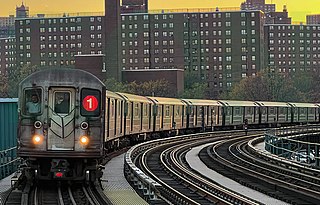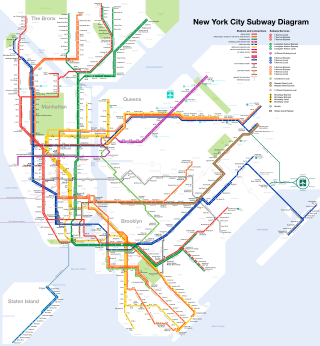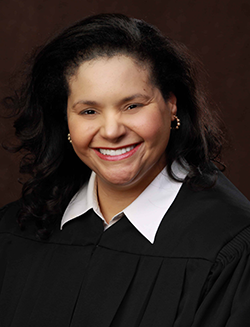Related Research Articles
Negligence is a failure to exercise appropriate care expected to be exercised in similar circumstances.

The New York City Subway is a rapid transit system in the New York City boroughs of Manhattan, Brooklyn, Queens, and the Bronx. It is owned by the government of New York City and leased to the New York City Transit Authority, an affiliate agency of the state-run Metropolitan Transportation Authority (MTA). Opened on October 27, 1904, the New York City Subway is one of the world's oldest public transit systems, one of the most-used, and the one with the most stations, with 472 stations in operation.
On December 22, 1984, Bernhard Goetz allegedly shot four youths on a New York City Subway train in Manhattan after they allegedly tried to rob him. All four victims survived, though one, Darrell Cabey, was paralyzed and suffered brain damage as a result of his injuries. Goetz fled to Bennington, Vermont, before surrendering to police nine days after the shooting. He was charged with attempted murder, assault, reckless endangerment, and several firearms offenses. A jury subsequently found Goetz guilty of one count of carrying an unlicensed firearm and acquitted him of the remaining charges. For the firearm offense, he served eight months of a one-year sentence. In 1996, Cabey obtained a $43 million civil judgment against Goetz after a civil jury ruled Goetz as liable, equivalent to $84 million today.

The 42nd Street Shuttle is a New York City Subway shuttle train service that operates in Manhattan. The shuttle is sometimes referred to as the Grand Central/Times Square Shuttle, since these are the only two stations it serves. The shuttle runs at all times except late nights, with trains running on two tracks underneath 42nd Street between Times Square and Grand Central; for many decades, three tracks had been in service until a major renovation was begun in 2019 reducing it to two tracks. With two stations, it is the shortest regular service in the system by number of stops, running about 2,402 feet (732 m) in 90 seconds as of 2005. The shuttle is used by over 100,000 passengers every day, and by up to 10,200 passengers per hour during rush hours.

Diane Alexis Whipple was an American lacrosse player and college coach. She was killed in a dog attack in San Francisco on January 26, 2001. The dogs involved were two Presa Canarios. Paul Schneider, the dogs' owner, is a high-ranking member of the Aryan Brotherhood and is serving three life sentences in state prison. The dogs were looked after by Schneider's attorneys, Robert Noel and Marjorie Knoller, a husband and wife who lived in the same apartment building as Whipple. After the fatal attack, the state brought criminal charges against the attorneys. Noel, who was not present during the attack, was convicted of manslaughter. Knoller, who was present, was charged with implied-malice second-degree murder and convicted by the jury. Knoller's murder conviction, an unusual result for an unintended dog attack, was rejected by the trial judge but ultimately upheld. The case clarified the meaning of implied malice murder.
Louise Woodward, born in 1978 (age 45–46), is a British former au pair, who at the age of 18 was charged with murder, but was subsequently convicted of the involuntary manslaughter of eight-month-old baby Matthew Eappen, in Newton, Massachusetts, United States of America.

The W Broadway Local is a rapid transit service of the New York City Subway's B Division. Its route emblem, or "bullet", is colored yellow since it uses the BMT Broadway Line in Manhattan.

Palsgraf v. Long Island Railroad Co., 248 N.Y. 339, 162 N.E. 99 (1928), is a leading case in American tort law on the question of liability to an unforeseeable plaintiff. The case was heard by the New York Court of Appeals, the highest state court in New York; its opinion was written by Chief Judge Benjamin Cardozo, a leading figure in the development of American common law and later a United States Supreme Court justice.

The New York City Subway is a rapid transit system that serves four of the five boroughs of New York City, New York: the Bronx, Brooklyn, Manhattan, and Queens. Its operator is the New York City Transit Authority, which is itself controlled by the Metropolitan Transportation Authority of New York. In 2015, an average of 5.65 million passengers used the system daily, making it the busiest rapid transit system in the United States and the 11th busiest in the world.

The Seventh Avenue station is an interchange station on the IND Sixth Avenue Line and the IND Queens Boulevard Line of the New York City Subway. Located at the intersection of Seventh Avenue and 53rd Street in Manhattan, it is served by the D and E trains at all times, and the B train on weekdays.

The 181st Street station is a station on the IRT Broadway–Seventh Avenue Line of the New York City Subway. Located at the intersection of St. Nicholas Avenue and 181st Street in the Washington Heights neighborhood of Manhattan, it is served by the 1 train at all times.

Most trains on the New York City Subway are manually operated. As of 2022, the system currently uses automatic block signaling, with fixed wayside signals and automatic train stops. Many portions of the signaling system were installed between the 1930s and 1960s. Because of the age of the subway system, many replacement parts are unavailable from signaling suppliers and must be custom-built for the New York City Transit Authority, which operates the subway. Additionally, some subway lines have reached their train capacity limits and cannot operate extra trains in the current system.
Robert A. Clifford is a Chicago trial lawyer and principal partner at Clifford Law Offices. Clifford's firm specializes in "personal injury, medical malpractice, mass torts, consumer and health care fraud, product liability, and aviation and transportation disasters." He attended DePaul University for both his undergraduate work and Juris Doctor, finishing in 1976. The firm was founded in 1984 to represent plaintiffs in personal injury and wrongful death cases.

Trimarco v. Klein Ct. of App. of N.Y., 56 N.Y.2d 98, 436 N.E.2d 502 (1982) is a 1982 decision by the New York Court of Appeals dealing with the use of custom in determining whether a person acted reasonably given the situation. It is commonly studied in introductory U.S. tort law classes.

Martin v. Herzog, Ct. of App. of N.Y., 228 N Y. 164, 126 N.E. 814 (1920), was a New York Court of Appeals case.

Tedla v. Ellman was a 1939 New York Court of Appeals case that was influential in establishing the bounds of the negligence per se doctrine. Ordinarily, a statutory violation automatically constitutes negligence. However, the court, in an opinion written by Irving Lehman, instead held that because this violation occurred in a situation not anticipated by the drafters of the statute and the violation was in keeping with the spirit of the statute, it did not constitute negligence.
Karla Moskowitz is a retired Associate Justice of the New York Appellate Division of the Supreme Court, First Judicial Department.
Warger v. Shauers, 574 U.S. 40 (2014), was a unanimous decision by the United States Supreme Court, ruling that jurors may not testify about what occurred during jury deliberations, even to expose dishonesty during jury selection or voir dire. The Court delivered its ruling on December 9, 2014.

In American tort law, the Baseball Rule is an exculpatory clause applicable to baseball games with spectators; it holds that a baseball team or its sponsoring organization cannot be held liable for injuries suffered by a spectator struck by a foul ball batted into the stands, under most circumstances, as long as the team has offered some protected seating in the areas where foul balls are most likely to cause injuries. This is considered within the standard of reasonable care that teams owe to spectators, although in recent decades it has more often been characterized as a limited- or no-duty rule, and applied to ice hockey and golf as well. It is largely a matter of case law in state courts, although four states have codified it.

Ada Elene Brown is an American lawyer who is a district judge of the United States District Court for the Northern District of Texas. She is a former trial judge of the Dallas County courts and a former Justice of the Fifth Court of Appeals of Texas. She was the first African-American woman federal judge nominated by President Donald Trump and confirmed by the Senate. She is also the first African American woman to sit as a federal judge in the 140- year-history of the Northern District of Texas.